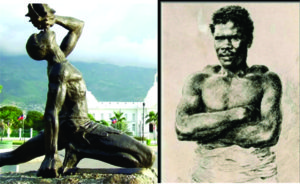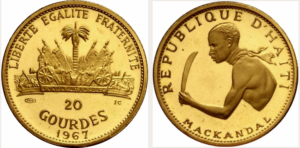
Francois Macandal was a charismatic and skilled leader of a slave revolt in Haiti in the 18th century. Macandal was probably of West African or Congolese origin brought to St Domingue as a slave at the age of 12, it is believed he was sold to Lenormand plantation.
As an adult he escaped the plantation and lead a revolt against French slaver owners and plantations. He was supposed to have a lost his left hand and part of his left arm while a slave. How this happened is often disputed; some sources claim his arm was crushed in an accident with a Sugar press and then he was cast out from the plantation; other historians said he fled the plantation after being sentenced to 50 lashes (which would kill most people), but the plantation owners were loath to admit a slave had the skill and brains to escape his white captors.
The anthropologist Mark Davis puts forward the theory based on carefully filtered oral history that Macandal had been well educated before he was a slave and could both read and write Arabic fluently, a possibility due to the contact of Arab slavers and traders in the Congo and West Africa; that Macandal was intelligent and well versed in herbalism is without doubt.
Whatever his origin, 12 years after fleeing the plantation, Macandal united a group of ‘Marows or Maroons in the remote mountain areas of Haiti to fight the French. The Maroons were a mixture of the surviving American Indians and escaped black slaves. The native population, the Tainos, had been nearly exterminated by first Spanish and then French colonization, who introduced diseases and slavery.
The Maroons combined both Native American wilderness skills with Africa agriculture and skills brought by the escaped slaves of many nations. Macandal became a guerrilla leader uniting various isolated communities in the mountains to strike back against the colonists. He used slaves still working on the plantations as intelligence network while his Maroon forces would raid and burn plantations.

Macandal and his guerrillas used local plants to produce poison which was then given to slaves to poison their masters. This was an excellent terror weapon and the French authorities feared that many land owners would leave Haiti because of the risk of poisoning, it is estimated that Macandal’s forces killed over 6,000 during the 6 years of insurrection.
On 20th January 1758 Macandal was sentenced to be burnt at the stake, a common punishment for slaves, following his betrayal by a female slave who was tortured after capture.
He was renowned for escaping capture, and many stories surround his death; some say that he escaped as the ropes binding him to the stake were loose due to the stump of his left hand; other stories are of a mythical nature claiming that his soul escaped the flames and his spirit still wanders Haiti.
Many of these were rooted in the fact that Macandal was a Voodo Houngan or priest and often prophesied that one day the slaves would win their freedom. He also claimed that his was immortal.
Macandal in many ways sowed the seeds for the later success of Toussaint L’Ouverture who was to lead the first successful revolt against European colonial powers.
A 20 gourd Haitian coin was struck in Macandal’s name in 1967. It’s avidly sought after by collectors.


